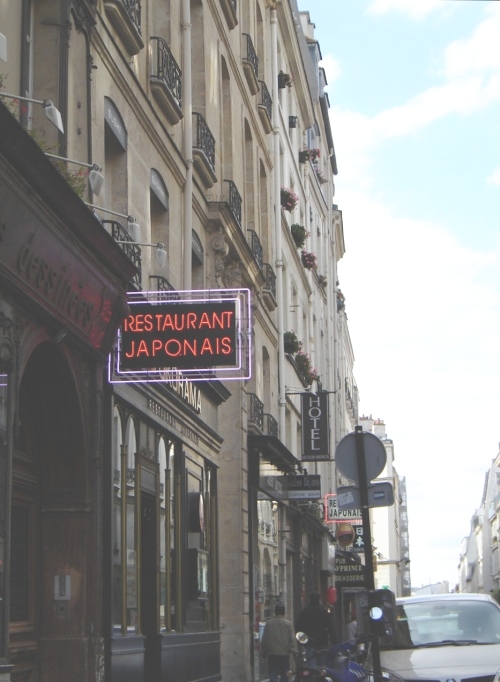
We've got a cute one-bedroom apartment on the fourth floor of a building at 44 Rue Monsieur le Prince — which sounds so much nicer than what I jokingly call it: "Mister the Prince Street". It's in the 5th arrondissement, a little bit east of Jardin du Luxembourg. As you walk to it from the south, this is what you'll see:

As we walked around the apartment we noticed several lights hung at a height of 5 feet, the most inconvenient being directly in front of the sink. The landlord said, "My wife is quite short. You will have many confrontations with this lamp."
He was right — and so far, the lamp has won every time.
There are some other quirky features. For example, there's broadband internet — but you can't use the phone while using the computer! Instead, the phone will take a message... which you can then access via the television.
Despite all this, the place is charming:
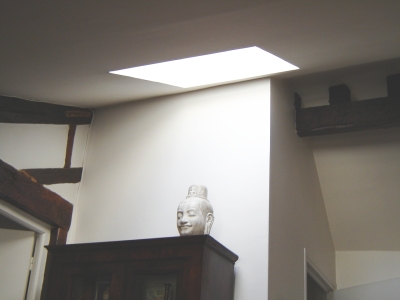
July 2, 2007
Today we walked around the
Latin Quarter.
Here's Lisa in front of the Sorbonne:
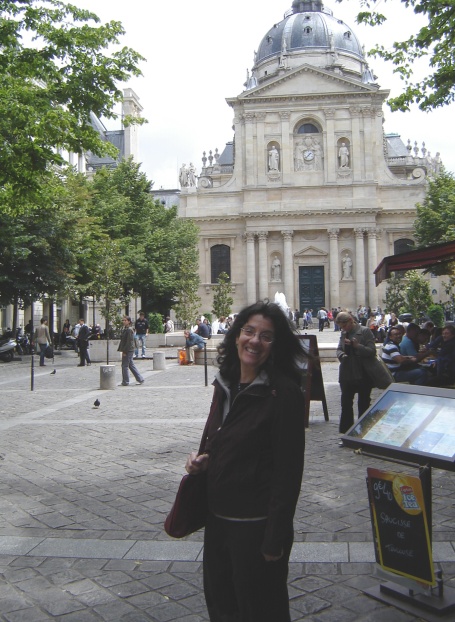
Today is the day that exam scores were posted for all schools in France, from elementary schools to the Sorbonne. Students and some parents lined up, anxiously awaiting the results:
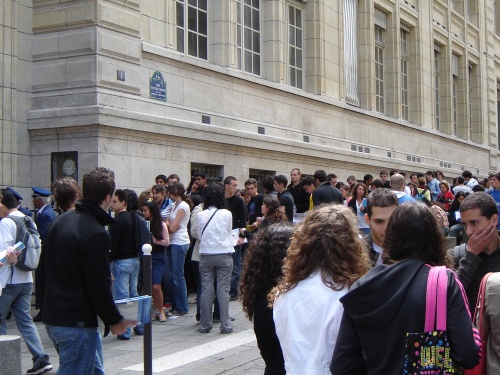
Perhaps it was no coincidence that many cars parked next to the Sorbonne had these fliers placed on their windshields, advertising math tutoring:
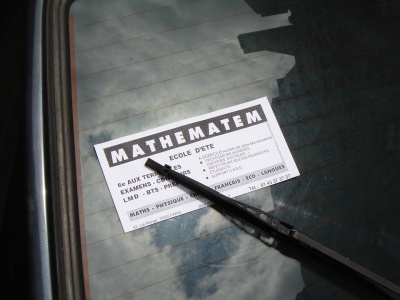
Just for fun, I began
taking photographs of streets named after mathematicians...
or more precisely, of the street signs. Here are two guys
who probably didn't need tutoring to pass their math exams:
Descartes
you surely know.
Paul Painlevé may be most famous as a politician in France, but
mathematicians know him for
his
work on differential equations.
I need to get Rue Monge and Rue Laplace!
A few days ago
Lisa installed wireless internet in our apartment, after I bought
a nice little portable wireless router at fnac for this purpose. It worked nicely, but the
next morning the TV stopped working — all the gadgets in this
joint are connected. After some struggle we managed to get the
phone to work even when the wireless internet was on, but the TV
remained recalcitrant. This evening the landlord came and did
his best, but gave up and said his wife would try later.
In the afternoon Lisa's friend Agnes Chalier visited:
After tea, we all walked over to the
Right Bank:
On the way back home, I took a detour and got a shot of Rue
Monge:
Over at the n-Category Café,
someone pointed out a list of mathematicians with Paris streets
named after them. There are over a hundred!
But, it looks like Rue Malus and Rue Malebranche are the only ones
left in the 5th arrondissement. In the 6th, just Rue Le Verrier!
So, soon I'll have to go further
afield if I want to keep playing this game.
As David Corfield
points out, I can get Rue Newton, Rue Euler, Rue Galilée and Rue Kepler
if I go south of Étoile, a big intersection north of the Seine.
But in case you're wondering: I'm doing lots of other fun stuff,
too!
Louis de Broglie won the Nobel prize in physics for his work on the
wave nature of the electron, but for some reason he's listed in the MacTutor
biographies of mathematicians and (more importantly) the list of mathematicians
with Paris streets named after them. So, I decided to give him
the benefit of the doubt. His brother
Maurice
was an experimental physicist who worked on X-ray diffraction and
spectroscopy.
First, the Islamic
art, which helped satisfy my yearning for everything to do with
Andalusia. The richness of art, philosophy, science and technology
not just in Granada and Cordoba, but in Cairo, Baghdad, Isfahan and many
other capitals, all while Europe was suffering through the dark ages,
is somehting I find very alluring.
I really like this celestial sphere
— acquired in Cairo in the 1800s,
it's an Indian copy of one made in Iran around 1285.
Click on the image for a more detailed version, where you can see the
Arabic script:
Then, Italian Renaissance painting.
It's amazing to walk through
galleries, stumble on a strikingly expressive portrait, and discover
that it's a da Vinci.
This is a painting of Lucrezia Crivelli, the second mistress
of
Ludovico Sforza,
duke of Milan in the latter half of the 1400s.
The painting is called
La Belle
Ferrionère, after the chain on her forehead,
called a ferronière.
I'd seen a somewhat similar portrait by Da Vinci in the National
Gallery in Washington D.C. — sometimes also called
La Belle Ferronière, but more commonly
the Lady with an Ermine.
I thought I'd be too jaded
by images of the Mona Lisa to get excited by the real thing...
but to my surprise, I was tremendously moved by the vast crowds
gathered to see it, like pilgrims paying reverence to a holy icon.
The cameras flashing, the video recorders, the cell phones held aloft
to capture a glimpse, almost overwhelmed the tiny painting itself.
This feeling — of an almost pathetic fragment of the past being
cherished and nearly overwhelmed by adulation — of the tragic
erosion of history under the ravages of time — struck me even
more strongly as I ascended the steps towards the
Winged Victory of Samothrace.
From the
Wikipedia article:
The statue stands on a rostral pedestal of gray marble representing the
prow of a ship, and figures the goddess as she descended from the skies
to the triumphant fleet. Rendered in white Parian marble, the figure
originally formed part of the Sanctuary of the Great Gods.
Before losing her arms, Nike's right arm was raised, either to bring
a trumpet to her lips as she is depicted on coins or to crown the naval
victor. The prow is made of grey marble from Lartos. The statue
has been reassembled in stages since its original discovery in 1863.
The prow was reconstructed from marble debris at the site by Champoiseau
in 1879 and assembled in situ before being shipped to Paris.
The discovery in 1948 of the hand raised in salute, which matched
a fragment in Vienna, established the modern reconstruction.
The right wing is a symmetric plaster version of the original left one.
Various other fragments have since been found: in 1950 one of the
statue's hands was found on Samothrace and is now in a glass case
in the Louvre next to the podium on which the statue stands.
Neither the arms nor the head have been found.
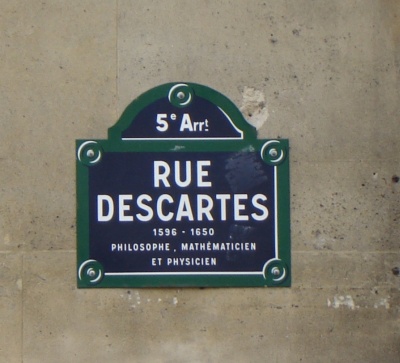
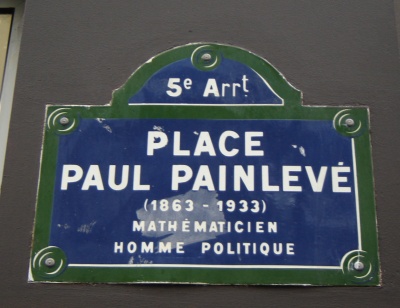
July 6, 2007
I'm developing a routine of meeting Paul-André Melliès
at Café Rostand at 10 in the morning. We've been discussing
category theory.
July 7, 2007
In the morning Lisa and I had our usual croissants and coffee —
there's a bakery downstairs, and each day the aroma of fresh-baked
croissants drifts up, so they're hard to resist.
We went on a long walk to the west end of Saint-Germaine, looking
for a market that sold soap, not finding it.
Then we walked back east along the Seine, then down south a bit —
where I managed to snap a picture of Rue
Lagrange:
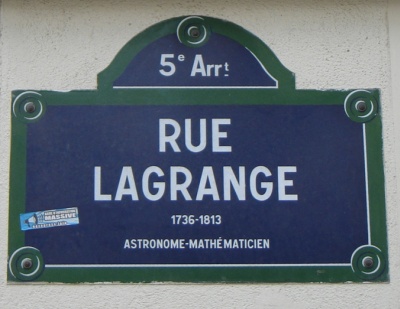
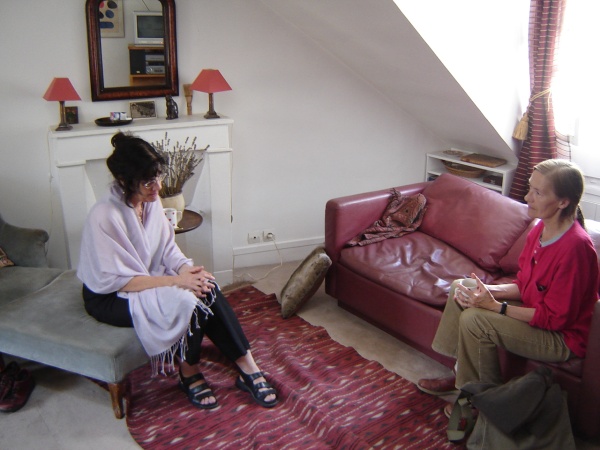
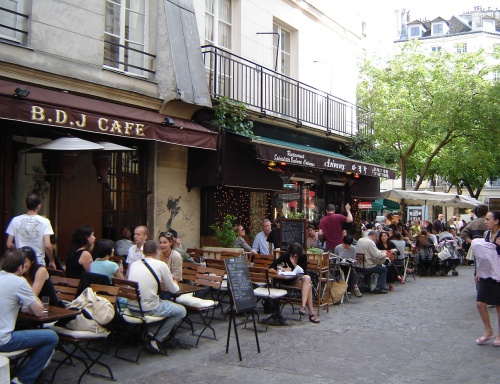
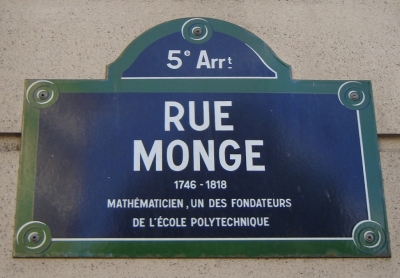
July 8, 2007
I bagged another one — Rue Laplace, just north of the Pantheon:
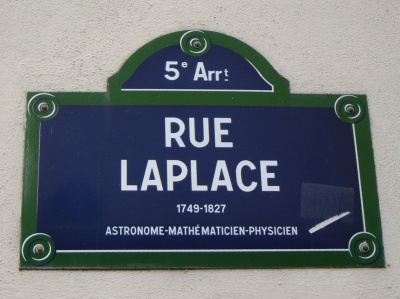
July 10, 2007
Today I gave a talk on Derek Wise's work at
Université Paris 7, down in the 13th arrondissement.
That gave me a chance to photograph this street sign:
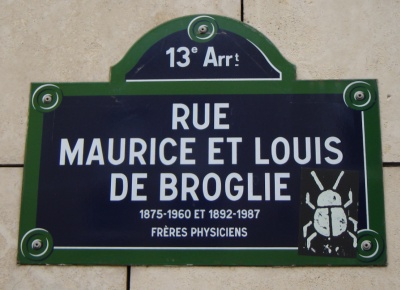
July 12, 2007
Today Lisa and I went to the Louvre. We viewed a few carefully
chosen slices of their enormous collection.
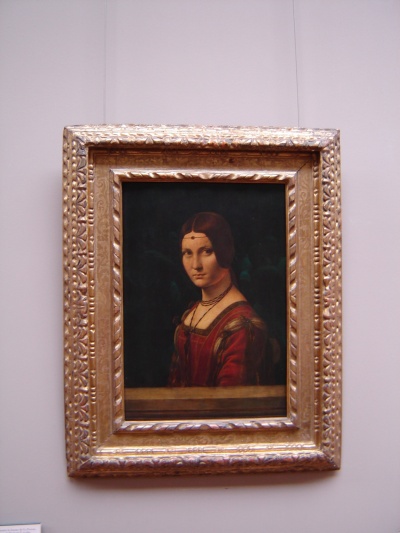
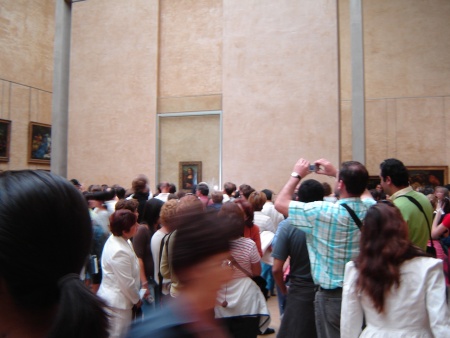

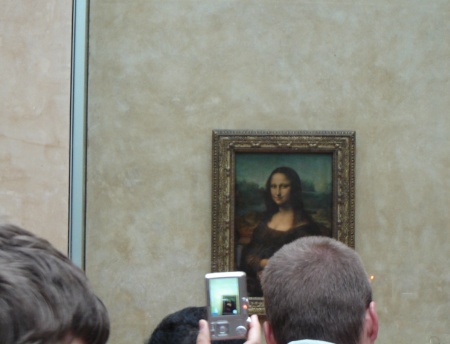
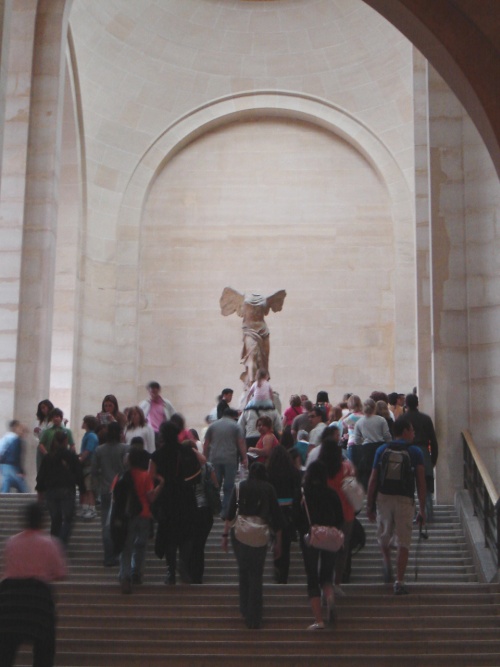
The Victory is one of the great surviving masterpieces of sculpture
from the Hellenistic period, despite the fact that the figure is
significantly damaged, missing its head and outstretched arms.
By an unknown artist, (presumably Rhodian in origin), the sculpture
is thought to date from the period 220 to 190 BC.
The past is not only passed, physics tells us that
much of it is truly erased, and in a very real sense does not
exist — any more than the future does.
The broken Venus
de Milo yet again made me think how many of our best achievements
are shattered or ruined — and perhaps loved all the more precisely
for that reason.

While standing here, I overheard a smartaleck teenager ask his friend: "Why does everyone feel they need to take photos of famous stuff they've already seen?"
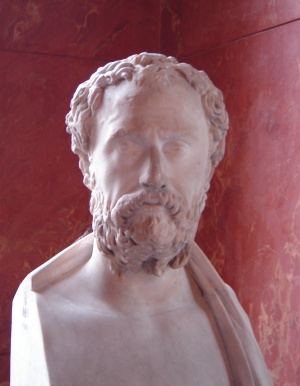
One can react to the mortality of all things philosophically, like Marcus Aurelius here, once emperor of Rome and now a statue among many in the Louvre, who wrote:
Or one can immerse oneself in the moment, like this Roman child... or this Roman duck:
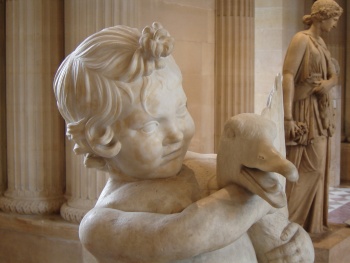
The fellow who decorated the walls would probably say I need to lighten up:
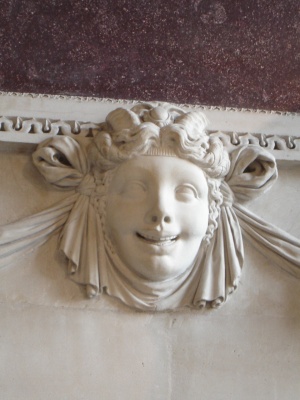
July 15, 2007
In Paris, fire stations hold public dances on the night before
Bastille Day! Unfortunately we missed those. Yesterday,
on Bastille Day itself, we went on a long walk around
Montparnasse.
We missed the military parade, which for the first time featured
troops from throughout the European Union.
After dinner, we caught a nice
glimpse of the
fireworks
near the Eiffel Tower by standing west of the
Pantheon.
But today, we saw the most impressive and cheerful sight of all: people lining up to try riding bikes from the new Parisian communal bike program!

A New French Revolution's Creed: Let Them Ride Bikes
Katrinn Benhold, New York TimesPARIS, July 15 — About a dozen sweaty people pedaled bicycles up the Champs-Élysées on Sunday toward the Arc de Triomphe, as onlookers cheered.
These were not the leading riders of the Tour de France racing toward the finish line, but American tourists testing this city's new communal bike program.
"I'm never taking the subway again," said a beaming Justin Hill, 47, a real estate broker from Santa Barbara, Calif.
More than 10,600 of the hefty gray bicycles became available for modest rental prices on Sunday at 750 self-service docking stations that provide access in eight languages. The number is to grow to 20,600 by the end of the year.
The program, Vélib (for "vélo," bicycle, and "liberté," freedom), is the latest in a string of European efforts to reduce the number of cars in city centers and give people incentives to choose more eco-friendly modes of transport.
"This is about revolutionizing urban culture," said Pierre Aidenbaum, mayor of Paris's trendy third district, which opened 15 docking stations on Sunday. "For a long time cars were associated with freedom of movement and flexibility. What we want to show people is that in many ways bicycles fulfill this role much more today."
Users can rent a bike online or at any of the stations, using a credit or debit card and leave them at any other station.
A one-day pass costs 1 euro ($1.38), a weekly pass 5 euros ($6.90) and a yearly subscription 29 euros ($40), with no additional charges as long as each bike ride does not exceed 30 minutes. (Beyond that, there is an incremental surcharge, to make sure that as many bikes as possible stay in the rotation.)
I forgot my camera, so all the pictures that follow were taken by Lisa.
We met the astrophysicist Cécile Barbachoux at the entrance of what seemed like a typical dull modern office. She then led us through it into a wonderful world full of gardens and old buildings.
The first thing we saw were these stables:
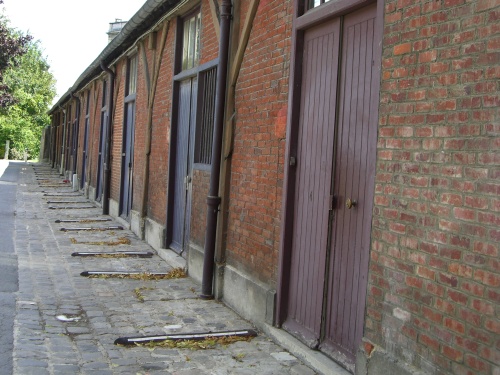
They're now used as rooms for constructing astronomical equipment, but the observatory was constructed at the behest of Louis the Fourteenth, starting around 1667, when horses were very much the thing.
We then walked past some gardens and came to the house where the director of the observatory lives:
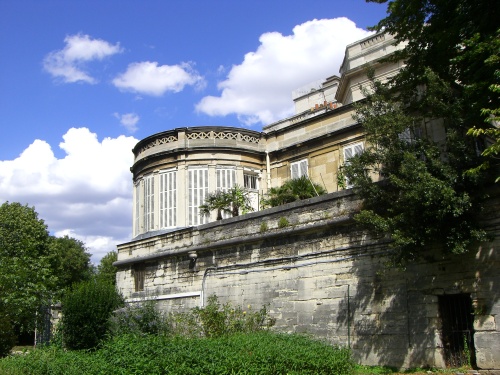
Note the spooky dark doorway below — there are many secret passages, stairways, and underground laboratories here!
The first director of the observatory was Giovanni Domenico Cassini, who apparently lived in this location before the observatory was even built. He's famous for discovering the first 4 moons of Saturn, the Cassini division in Saturn's rings, the Great Red Spot of Jupiter, and so on.
Rounding the bend we came to the grand entrance and saw a big statue of Urbain Le Verrier, who was director from 1873 to 1877. Le Verrier specialized in celestial mechanics, and used perturbations in the orbit of Uranus to predict the location of Neptune.
Even more interesting to me was this plaque:

Here is where Ole Rømer measured the speed of light in 1676! — with the help of Christiaan Huygens, and the shadow of Jupiter's moon Io. As someone fascinated by relativity, the first measurement of something so important as "la vitesse de propagation de la lumière" has always seemed very exciting to me.
Inside the observatory, Cécile used her specially procured ring of keys to open various secret doors and show us wonders starting with Foucault's telescope, which is made of wood:
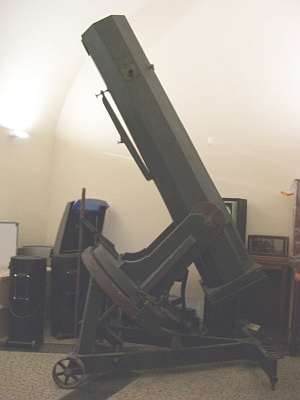
Léon Foucault is more famous for his pendulum, which he used to demonstrate the rotation of the Earth. In fact, every scientist in Paris received an invitation to L'Observatoire de Paris to see this pendulum on February 3rd, 1851. Napoleon III later created a post of Physicist Attached to the Imperial Observatory specially for Foucault, during the time Le Verrier was director, and this is when Foucault began making telescopes.
We then ascended many flights of stairs until we reached the roof:
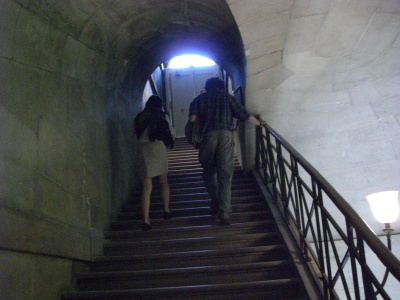
where we saw a marvelous view of Paris.
We scrambled over the roof and entered the observatory proper:
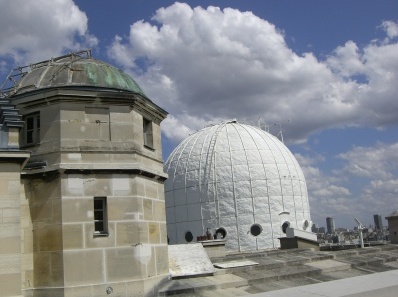
Inside, it was very dark, and dominated by a huge telescope:
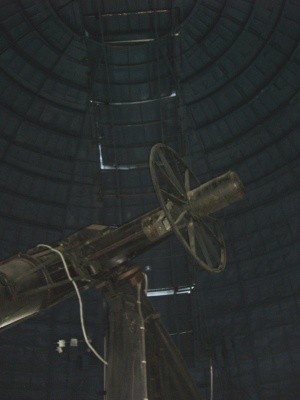
Apparently this old telescope is still used in some demonstrations, just for fun — but nowadays, even a small modern telescope can do better.
We then descended a small spiral staircase, getting a nice view of the steel reinforcements that support the heavy telescope, and eventually worked our way to the library. Here we saw many more nice old telescopes:
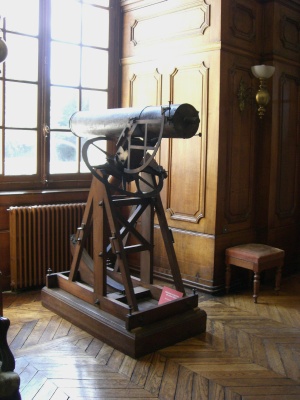
We also saw sextants, globes, celestial spheres, heliostats, and other curiosities — for example, a marble statue of Cassini, as well as this one of Laplace:
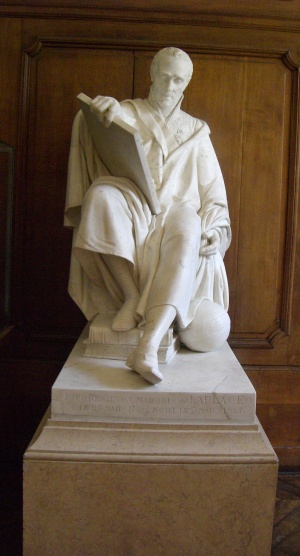
The celestial sphere at his feet is a nice classical allusion: it reminds me of a statue of Athena in the Louvre, where she is for some reason holding such a sphere, more typically the property of Urania.
Pierre-Simon Laplace is now most famous for his work on probability theory, celestial mechanics and the like, but he also directed L'Observatoire de Paris. The astronomer Delambre later wrote:
... never should one put a geometer at the head of an observatory; he will neglect all the observations except those needed for his formulas.This could equally well have been said about Hamilton, who also lived in an observatory, and made his wife do most of the observations!
To reach her office, she needs to climb yet another twisty little spiral staircase — the place is full of them. I find it very romantic, but I wonder how many aging astronomers have plunged to their deaths here.
She showed us this astrolabe:
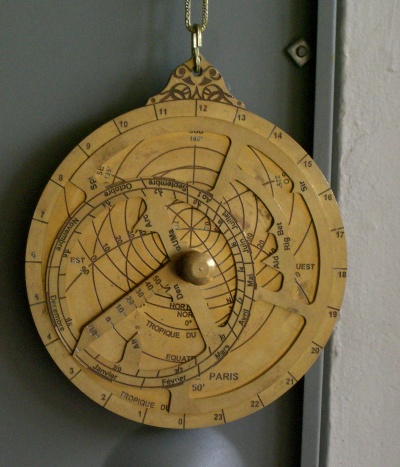
This was made by a 16-year-old student as part of the observatory's educational program!
On our way out, we caught a nice view of some smaller observatories:
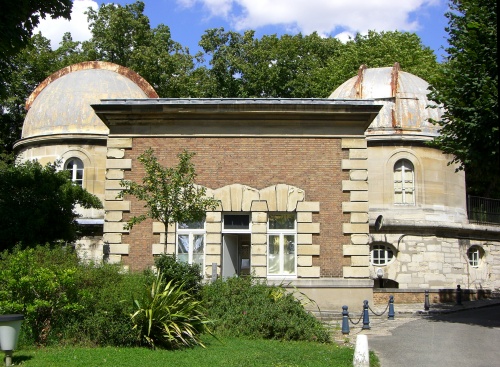
We then met the mathematician Joseph Kouneiher and went to a café near Montparnasse. Much to my surprise, Joseph told us that Leibniz had invented a calculating device, the stepped reckoner, in 1674. Two prototypes were built. One was lost in an attic of the University of Göttingen until a worker found it in 1879 — while fixing a leak in the roof! It's now in the State Museum of Hanover.